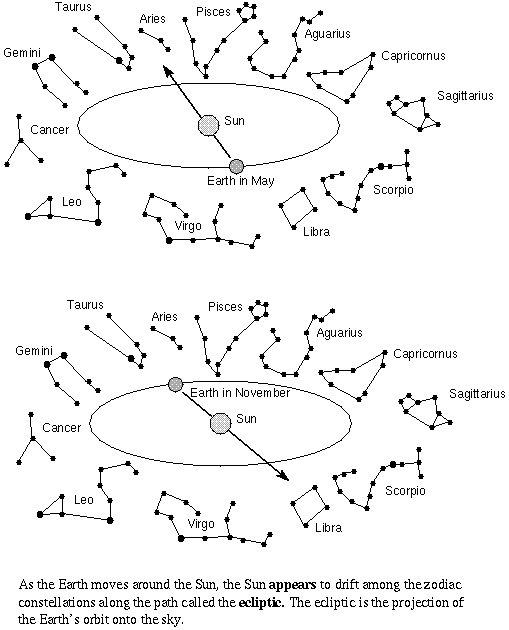 |
Department of Physics | AstroLab |
Solar Days and Sidereal Days
Solar time is time measured with respect to the Sun's apparent motion in the sky. The clocks we use for civil timekeeping are based on this motion. Of course, the apparent motion of the Sun across the sky is actually caused by the rotation of the Earth. So, our clocks measure the length of time required for the Earth to rotate once with respect to the Sun. From our perspective, the Sun revolves around the Earth every 24 hours. This period is known as a solar day.
Sidereal time is time measured with respect to the apparent motion of the 'fixed' stars in the sky due to the Earth's rotation. While the Earth is rotating on its axis it is also moving along its orbit around the Sun. Over the course of a day the Earth moves about one degree along its orbit (360° in a full orbit divided by 365.25 days in a year is about one degree). Therefore, from our perspective, the Sun moves about one degree from west to east with respect to the 'fixed' stars.
All of this means that according to our clocks, which are based on solar time, a given star will rise or set about four minutes earlier each day (the Earth rotates 15° in one hour, i.e. 360/24, so one degree of rotation is equivalent to about four minutes of time). For example, a star that rises at 9:00pm (21:00) tonight will rise at 8:56 pm (20:56) tomorrow and at 8:52pm (20:52) the next night. One month later that star will rise or set two hours earlier. In other words, from our perspective, the stars revolve around the Earth in only 23 hours and 56 minutes. This period is known as a sidereal day.
On the Chart menu make sure that both the Horizon Mode option is selected and Horizon option is ticked. Click the S button and then the Z button on the toolbar. This makes CyberSky display a view of the entire sky with the south horizon at the bottom of the display. Now set the time to noon using the Noon command on the Time menu. You should now see the Sun at approximately due south.
Use the Time Step command on the Animation menu to set the animation time step to one solar day. Then click the "play forward" button to start animation. If you look at the local time displayed at the top of the Data bar you will see that the time is not changing but the date is advancing one day per animation step. As the days rush by the Sun remains approximately fixed in the south direction. The apparent yearly path that the Sun tracks on the celestial sphere is called the ecliptic, i.e. the projection of Earth's orbital plane on the celestial sphere. This circular path is tilted by 23.5° with respect to the celestial equator because the Earth's rotation axis is tilted by 23.5°with respect to its orbital plane. If the Earth's axis was not tilted, the Sun would be motionless in the display. Toggle the Ori button on the bottom tool bar to display the names of the constellations. The zodiac is the set of constellations through which the ecliptic passes.

Note how on about the 21st June the Sun reaches its highest point and on about the 21st December reaches its lowest point and how on about 21st March and 21st September it passes thru the celestial equator. So while the Sun remains approximated fixed in south, the stars, are moving from east to west at a steady rate. Here we are just seeing the reflection of the Earth's motion around the Sun. Note how as the Earth, i.e. your viewpoint, moves around the Sun, the various planets move in and out of view approximately tracking the ecliptic.
Toggle off the constellation names, e.g. the Ori button at the bottom, use the Time Step command on the Animation menu again but this time to set the animation time step to one sidereal day. Click on "play forward" button to start animation. If you look at the local time displayed in the legend you will see that the date is advancing one day per animation step and the time is about four minutes earlier at each step. Your line of sight now remains fixed toward the stars, so they are motionless in the display. The Sun and planets move in and out of your view along the ecliptic.
As is the case with solar days, sidereal days are also divided into hours, minutes, and seconds. Naturally, these hours, minutes, and seconds are shorter than the solar hours, minutes, and seconds you are familiar with. One solar day is 24 solar hours long, and one sidereal day is 24 sidereal hours long, but one sidereal day is 23 solar hours and 56 solar minutes long.
This exercise was based on a help section of CyberSky. A shareware version of CyberSky is available from http://www.cybersky.com . This version may be used free of charge on up to 21 separate days for the sole purpose of evaluating the software.
| Back to the AstroLab Home Page | jrl | 2013-Dec-22 23:31:17 UTC |